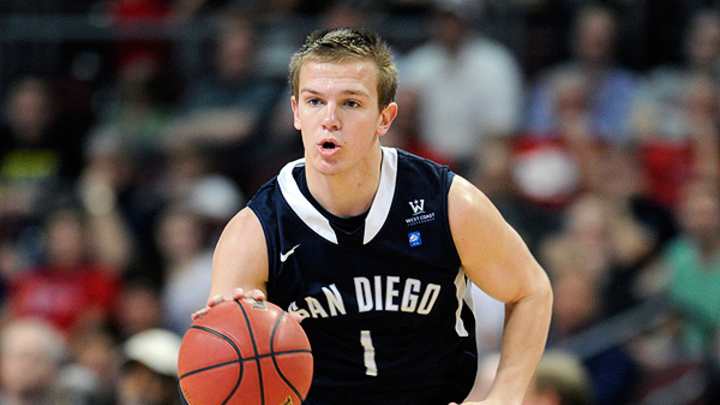The Chalkboard: San Diego guard Johnny Dee and the art of the free throw

Johnny Dee is the nation's third-best free throw shooter, connecting at a 93.8 percent clip. (William Mancebo/Getty)

Johnny Dee is a very good free-throw shooter. San Diego's junior guard makes 93.8 percent of his attempts, in fact, a rate eclipsed by only two other players in the nation. This nearly automated success at the stripe owes to routine and repetition, but also to the cutthroat chase of the crown.
Note: The crown is not an actual crown. At practice, either Dee or teammate/roommate Nick Kerr claims the crown by making the most free throws out of 100. Tangible award or not, it is a painstaking, pressure-packed pursuit, and winning the crown is far better than the alternative.
“It's nothing physical at all,” Dee said. “It's all trash talk and the fact that you're a loser. That's the penalty.”
The Toreros' leading scorer is no specialist – Dee averages 16.9 points per game and has 1,460 career points as the West Coast Conference tournament begins Saturday – but he is particularly deadly with a set shot from 15 feet. While in the midst of making 255 of 283 career free throws (90.1 percent) to date, Dee broke down the genesis of his routine, the maintenance of his form and how he's as surprised as anyone about this.
The setup. As with any shot, the lower body and base dictate almost as much as the arms and hands doing the hoisting. When Dee was in fourth grade, he read a book about Michael Jordan that discussed how one of the greatest basketball players ever set his feet for free throws.
Right foot slightly in front of the left foot, Dee read. And the right foot should point to the center of the rim. “I've went with that ever since,” Dee said.
The routine. Dee's father taught him how to shoot, and on the subject of free throws, he imparted advice just about every basketball player will hear: At the line, do the same exact thing every time.
As far back as seventh grade – which is as far back as Dee can remember – he landed on a relatively unadorned pre-shot pattern. Two dribbles, spin the ball once, two more dribbles, free throw. The rhythm dribbles allow him to catch his breath. The spin allows him to align his hands with the creases of the ball and to ensure a proper release.
“When you're playing the game, you can get kind of tired, you're running up and down the court,” Dee said. “I felt if I get to the free throw line, I want to make it long enough where I could catch my breath but not too long where I was thinking about it too long. It was kind of a happy medium. Two dribbles, spin, two dribbles and I felt comfortable and relaxed.”
But the mind keeps working as the body does. To quiet the noise from the outside or inside, Dee silently recites a Bible verse – Philippians 4:13. Depending on the translation, it reads I can do all things through him who gives me strength. It might have been Dad's idea, too, actually. “Just to remind myself that I know I'm confident shooting these free throws and I know I'm going to make them,” Dee said.
The release. Dee's release is fairly common as well. He brings the ball up after the fourth dribble just as he bends his knees, with one fluid motion sending it arcing toward the net. But before he releases it, Dee zeroes in on the back of the rim. There he found a tiny slit in the rim to serve as a prime target for his eyes – fixating on the front of the rim, he thought, might leave him open to missing short too often.
Finding that slit on the rim allows him to push away any commotion and also mitigates one of his idiosyncrasies. “A problem I always had, I like to track the ball after I shoot it,” Dee said. “That sometimes messes with the the touch that I use. So if I just focused straight back rim, I knew that's where I wanted to shoot it, and I'm using the right power I need to get it there.”
The maintenance. The Toreros' daily prescription for free throws ranges from 50 to 100 attempts, Dee included. There is no borderline psychotic volume of work involved, not even in the offseason; Dee's regular shooting routine involves 10 attempts from 10 spots on the floor with free throws in between. That naturally works out to about 100 free throws in the course of a summer workout.
And while a theoretical “crown” and the threat of trash talk infuses some humor into the shooting contests with Kerr, those contests permit Dee to approximate game-pressure conditions as best he can.
“I hate losing to him,” Dee said. “The other day, I was up three or whatever at 60 (attempts), but then I missed three in a row. And we were tied, 87-for-90, going into the last 10. So those last 10 free throws were pressure shots. Each one of them mattered to me. I knew I had no room for error.”
Dee won that day, wearing the crown proudly if not humbly. With a bit more sheepishness, he concedes that the outstanding success from the charity stripe is even more that he would expect. He claimed that he is “completely” surprised by his percentages pushing into the 90s.
But then the whole point is to take the surprise out of the equation, to settle into the same pattern, every single time, to make the shot routine.
